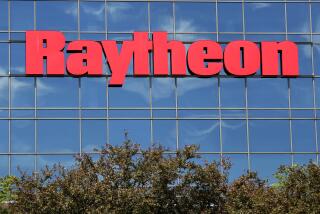Pentagon Pays for Contractors’ Toxic Cleanups
- Share via
With little public debate or congressional review, the Department of Defense is reimbursing big contractors millions of dollars for environmental cleanup costs, The Times has learned.
In recent years, the Defense Department has paid or agreed to pay cleanup costs that the firms could not recover from their insurance carriers, substantially reducing the contractors’ out-of-pocket expenses. Among the suppliers who benefit are Lockheed Corp., Boeing Co., Northrop Corp., Raytheon Co., General Electric Co., McDonnell Douglas Corp. and Aerojet General Corp., spokesmen for those firms confirmed in interviews.
Word of the arrangements has caught many government and environmental officials by surprise. Several Environmental Protection Agency and Justice Department officials responsible for ordering such firms to clean up toxic pollution said they knew nothing about the reimbursements.
The policy could make the government a key underwriter of the multibillion-dollar effort to restore the 1,228 Superfund sites. That’s because most big military contractors are liable for cleanups at multiple sites. The 10 largest contractors alone have been cited for potential Superfund liability 221 times, according to figures obtained from the EPA.
Under the Superfund program, the EPA identifies the worst toxic waste sites and orders those responsible to clean them. The Superfund law requires that private funds be used whenever possible. The Superfund--a pool of federal money--is to be tapped only when those responsible for the pollution are broke or can’t be found.
The Defense Department policy raises “a fairness question,” said Rep. Barbara Boxer (D-Greenbrae), a member of the House Armed Services subcommittee on investigations, in that it appears “that defense contractors are getting the government to clean up toxics when other companies” must go it alone.
“I don’t believe there’s too much oversight here,” said Boxer, who called for a General Accounting Office investigation after inquiries by The Times.
Among other things, Boxer said the GAO will try to determine how much “the government shelled out in the last 10 years to help” with toxic cleanups. She said the agency will also ask if the Defense Department is cleaning up pollution that did not result from defense work and whether the Pentagon is “being aggressive in taking the side of the taxpayers, or are they too quick to share liability for the pollution?”
The basis for repaying cleanup costs is the Federal Acquisition Regulation, a compendium of rules covering government contracts.
According to the regulation, the government is to reimburse costs that are “reasonable” and “ordinary and necessary to the conduct of the contractor’s business.” This is being interpreted to include environmental cleanups, which are billed as overhead expenses in current and future contracts.
“We include our environmental remediation costs in the overhead rates that we negotiate with the Department of Defense,” said Barbara Anderson of McDonnell Douglas. “It’s a fairly common practice throughout the industry.”
Critics, however, say the policy amounts to a bailout of wealthy corporations that should clean up after themselves.
“First, it’s unfair, it’s immoral, it’s wrong for the taxpayer to pick up the bill for military contractors,” said Lenny Siegel of the National Toxics Campaign Fund, an environmental group.
“But, more important, if Big Daddy . . . says: ‘Don’t worry about your environmental practices; we’ll bail you out any time you’re caught,’ then that’s not very much incentive for them to clean up their act,” Siegel said.
“I’m not sure how many taxpayers are even aware that this is going on,” said Kevin Page of the Project on Government Procurement, a private group that monitors U.S. military and environmental spending.
In defending the policy, representatives of Defense Department suppliers and the Pentagon noted that non-defense corporations working for private customers also pass along normal business costs, including environmental expenses. They say the contractors--whose customer is the government--are merely doing the same.
The best approach “is going to be one that gets the country cleaned up,” said a Pentagon official who spoke on condition of anonymity. “We, as purchasers of goods, shouldn’t be expected not to pay our fair share of doing that.”
Others maintain that defense firms generally weren’t breaking the law when they polluted and so should not be left holding the bag.
The cost to the federal government will depend, in part, on how much cleanup money the contractors obtain from their insurance carriers, but officials acknowledged that the federal tab could be huge because leading contractors are facing toxic cleanups at scores of sites.
It’s “a hidden cost that nobody’s facing up to, and that’s mounting,” said a lawyer who represents contractors.
Defense Department officials responding to The Times’ formal request for data under the Freedom of Information Act said they do not know how much they are paying in reimbursements.
“No estimates of the magnitude of current or future cleanup costs to be borne by (the Defense Department) are available,” the department said in a letter to The Times.
In one recent case, EPA and Justice Department officials proudly hailed a settlement requiring Lockheed to do up to $80 million worth of cleanup work at a Superfund site in Burbank.
But officials with those agencies later said they were stunned to learn of a prior arrangement under which the Defense Department had agreed to reimburse much of Lockheed’s costs in Burbank, where municipal water supply wells have been shut down by pollution, partly from Lockheed.
The memorandum calls for the government to pay cleanup costs that Lockheed is unable to recover under insurance policies or through claims against other suspected polluters. The memorandum states that “Lockheed has represented that the costs . . . are not the result of violation of applicable laws and regulations.”
Lockheed officials said they expect to bill the government perhaps $10 million annually for the next eight years to recoup the cleanup costs.
Environmental officials said they were surprised to learn of the Lockheed-Defense Department arrangement. “It’s the first time I’ve heard of it,” said Bruce Diamond, director of the EPA’s office of waste programs enforcement. “This issue has just not come up before.”
Lockheed is charging for three sites besides Burbank: the Operating Industries landfill in Monterey Park (a Superfund site), the Lockheed Missiles & Space Co. complex in Sunnyvale and Lockheed’s former Harbor Island shipyard in Seattle.
Lockheed “is entitled to claim these remediation costs as allowable costs of contract performance,” said company spokesman Scott Hallman.
Many other contractors also have billed cleanup expenses to the Defense Department. For instance, the Air Force last year agreed to reimburse Aerojet General $36.8 million for the cost of cleaning up its Rancho Cordova complex east of Sacramento.
The Air Force also has reached a preliminary agreement with Boeing to pay up to $27 million in cleanup expenses at two Superfund sites in Washington state that received wastes from Boeing, according to company and government officials.
A Boeing spokesman said the company also is billing the military for part of the ground water cleanup at a company plant in Wichita, Kan.
A spokeswoman for Northrop said that firm is charging to defense contracts its cleanup outlays at a North Carolina Superfund site.
Military contractors aren’t always successful in recouping cleanup costs, however. For example, the Army last May refused to allow FMC Corp. to include cleanup funds in a $1.1-billion order for Bradley Fighting Vehicles.
And the Air Force, although agreeing to reimburse $36.8 million worth of Aerojet General’s costs, has refused to pay continuing cleanup expenses at the Rancho Cordova site. The dispute is before the Armed Services Board of Contract Appeals at the Pentagon.
The Federal Acquisition Regulation also applies to other federal agencies that may be reimbursing contractors’ cleanup costs, according to a procurement official with the General Services Administration, who nevertheless said he was not aware of such cases.
Since the 1970s, the Department of Energy has funded two programs to clean up radioactive pollution left from contract work done for the old Atomic Energy Commission. Spending in each of these, however, is specifically authorized by Congress.
One initiative involves Manhattan Project sites contaminated in the 1940s and 1950s; the other involves old milling sites where uranium was processed for the AEC.
Staff writer Alan Miller contributed to this story from Washington.
More to Read
Get the L.A. Times Politics newsletter
Deeply reported insights into legislation, politics and policy from Sacramento, Washington and beyond. In your inbox three times per week.
You may occasionally receive promotional content from the Los Angeles Times.










